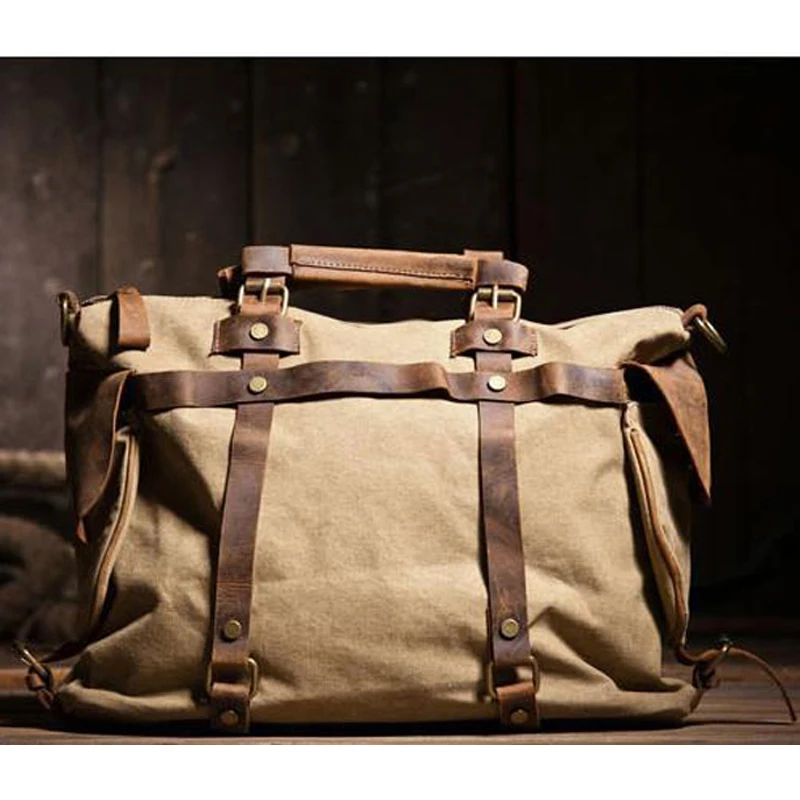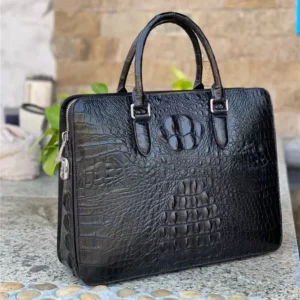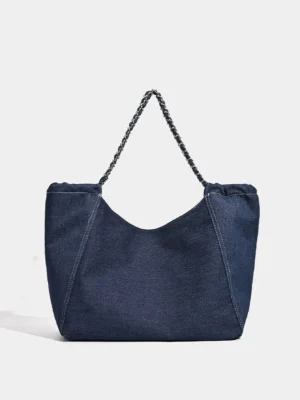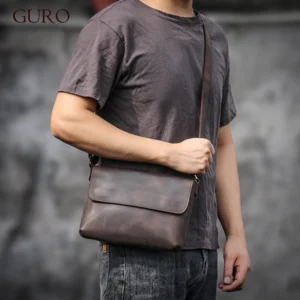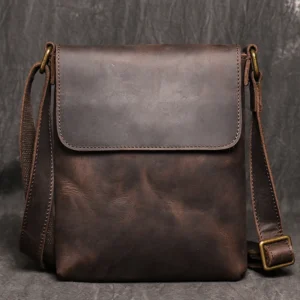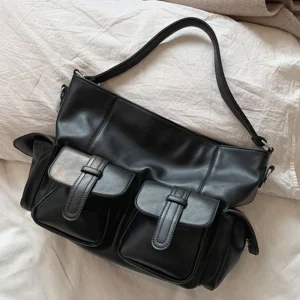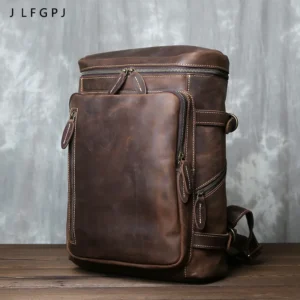Introduction: Understanding the Timeless Debate Between Leather and Canvas Messenger Bags
Messenger bags have traveled a long way from their utilitarian beginnings as tools for postal workers and bicycle couriers to become fashionable yet functional accessories for modern professionals. These versatile bags, characterized by their single shoulder strap design and flap closure, have earned their place in briefcases and backpacks alike for their accessibility and organization.
At the heart of choosing the perfect messenger bag lies a fundamental question: leather or canvas? This decision extends beyond mere aesthetics—it reflects your lifestyle priorities, budget considerations, and even personal values regarding sustainability and longevity.
Leather messenger bags offer timeless sophistication with their rich texture and ability to develop character over time. They tend to provide structure, professional appeal, and a certain gravitas that many professionals seek. Canvas options, meanwhile, present a more casual, lightweight alternative that often comes with greater affordability and design versatility.
The rising trend of conscious consumerism has added another dimension to this choice, with more buyers considering the environmental impact and ethical implications of their purchases. According to recent market research, messenger bags continue to gain popularity in professional settings, with over 30% of urban professionals citing them as their preferred daily carry option.
Understanding the leather vs canvas bag durability differences becomes essential when investing in an accessory you’ll likely use daily. This comprehensive guide aims to examine both materials across multiple dimensions—from durability and maintenance to style and cost—helping you determine which messenger bag material aligns best with your needs and values.
At-a-Glance: Leather vs Canvas Messenger Bag Comparison
| Feature | Leather Messenger Bags | Canvas Messenger Bags |
|---|---|---|
| Durability | High (10+ years with proper care) | Moderate (3-7 years depending on quality) |
| Weight | Heavier (typically 2-4 lbs empty) | Lighter (typically 1-2 lbs empty) |
| Maintenance | Regular conditioning required | Machine washable (untreated) or spot clean |
| Water Resistance | Natural resistance with treatment | Poor unless waxed or treated |
| Aesthetics | Professional, develops patina | Casual, more color/pattern options |
| Cost | Higher ($150-$500+) | More affordable ($50-$200) |
| Aging Characteristics | Develops rich patina | Shows wear, may fade or fray |
| Eco-Friendliness | Varies by tanning process | Generally better, especially organic options |
This table provides a quick reference point for comparing the key attributes of leather and canvas messenger bags. As you review these differences, consider which factors matter most for your specific needs and daily use scenarios. While some elements like aesthetics are subjective and depend on personal taste, others like weight and maintenance requirements have practical implications for everyday use.
The detailed canvas vs leather bags comparison reveals that neither material is universally superior—each excels in different areas. The sections that follow will explore these differences in depth, helping you determine leather vs canvas better options for your specific situation.
The Essence of Leather Messenger Bags: Timeless Sophistication
Leather messenger bags represent the pinnacle of refined professional accessories, with a heritage spanning centuries of craftsmanship. Understanding the different types of leather helps explain the significant price variation you’ll encounter in the market.
Types of Leather Quality
Full-grain leather stands as the highest quality option, using the entire thickness of the hide with all natural grain intact. This premium material develops a distinctive patina over time while offering unmatched durability. A step down, top-grain leather has had its uppermost layer sanded and refinished to remove imperfections, resulting in a more uniform appearance but slightly reduced durability. Genuine leather (despite the misleading name) represents lower-quality material made from the hide layers remaining after the top portions are used for better grades.
Craftsmanship Tradition
The creation of a fine leather messenger bag involves techniques refined over generations. Skilled artisans select hides, cut patterns with minimal waste, strengthen stress points with precision stitching, and finish edges to prevent fraying or splitting. This meticulous process contributes to both the higher price point and the exceptional longevity of quality leather bags.
Aesthetic Evolution
Perhaps the most distinctive characteristic of leather messenger bags is their ability to evolve aesthetically over time. Unlike most materials that simply wear out, quality leather develops a rich patina—a glossy surface that deepens in color and character with use. This means your full-grain messenger bag actually becomes more visually interesting and unique as you use it.
Professional Context
In professional environments where first impressions matter, leather messenger bags communicate attention to detail and investment in quality. They complement formal business attire seamlessly while transitioning effectively to business casual settings. The subtle statement of a well-crafted leather bag speaks to discernment and professional maturity without ostentation.
The premium positioning of leather messenger bags reflects both their material quality and craftsmanship requirements. When viewed as a long-term investment rather than a temporary accessory, the higher initial cost becomes more understandable in the context of a professional wardrobe.
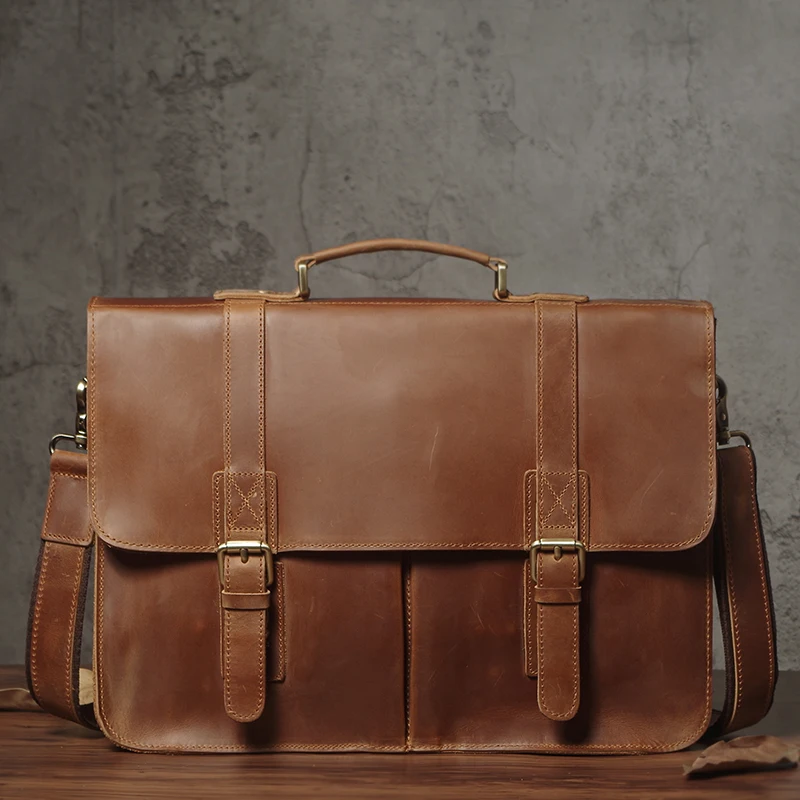
Advantages of Leather Messenger Bags: Beyond Beauty
- Exceptional Durability
Quality leather messenger bags offer remarkable longevity that few materials can match. With proper care, a well-crafted full-grain leather bag can easily last 10-15 years of regular use. The natural fiber structure of leather creates inherent strength, resisting tears and punctures while maintaining structural integrity. The material actually becomes more supple with use without losing its strength—a rare combination in the world of materials.
- Professional Appearance
Leather projects an executive presence that immediately elevates professional attire. The material’s natural luster and rich texture communicate attention to detail and quality consciousness. In client meetings, job interviews, and formal business settings, a leather messenger bag serves as a subtle yet powerful indicator of professionalism. This material adapts equally well to modern minimalist designs and classic vintage aesthetics.
- Patina Development
Perhaps the most unique advantage of leather is its ability to develop a rich patina over time. Unlike synthetic materials that simply look worn with age, quality leather develops a distinctive surface character that reflects its journey with you. Subtle color variations, gentle shine development, and a softening of the material create a personalized finish that cannot be manufactured. This makes leather messenger bags worth it for many professionals seeking a signature accessory.
- Structural Integrity
Leather naturally maintains its shape over years of use, resisting the sagging and structural collapse that affects many other bag materials. This shape retention ensures your bag continues to present well professionally throughout its lifespan. The natural firmness of leather also provides better protection for electronic devices and important documents carried within.
- Natural Water Resistance
Quality leather offers inherent water resistance, especially when properly treated. While not completely waterproof, leather’s natural oils repel light moisture and prevent immediate water penetration. Brief exposure to rain typically results in no damage, as water beads on the surface rather than immediately soaking through. This natural property can be enhanced with proper leather treatments.
- Investment Value
Despite higher initial costs, leather messenger bags often represent superior value when assessed on a cost-per-use basis. A quality leather bag costing $300 used daily for 10 years costs just pennies per use. Additionally, well-maintained leather bags can retain significant resale value, unlike most synthetic or canvas options that quickly depreciate after purchase.
Considerations for Leather Messenger Bags: Important Factors to Weigh
- Higher Initial Cost
Leather messenger bags require a more substantial upfront investment compared to canvas alternatives. Entry-level genuine leather bags typically start around $150, with premium full-grain options from respected manufacturers ranging from $300-$500+. This price difference reflects not only material quality but also the craftsmanship required to properly work with leather. While this cost can be justified through longevity, it represents a significant initial expenditure compared to alternative materials.
- Weight Factor
The natural density of leather creates heavier bags compared to canvas counterparts. The leather canvas weight differences become particularly noticeable when carrying the bag for extended periods. A typical leather messenger bag weighs 2-4 pounds empty, compared to 1-2 pounds for canvas alternatives. When filled with daily essentials like laptops and documents, this weight difference can impact comfort during commutes or travel.
- Maintenance Requirements
Leather demands regular care to maintain its appearance and durability. This includes periodic cleaning, conditioning to prevent drying and cracking, and protection from extended sun exposure or extreme temperatures. Most leather professionals recommend conditioning every 3-6 months depending on use and climate. While not overly time-consuming, this maintenance represents an ongoing commitment that some users may find burdensome.
- Environmental Concerns
Traditional leather production raises environmental and ethical considerations. The tanning process can involve chemicals that impact water systems, while raising animals for leather has its own environmental footprint. For the environmentally conscious consumer, this presents a legitimate concern. However, vegan leather messenger bag options have evolved significantly, offering alternatives that mimic genuine leather’s appearance and functionality with fewer environmental concerns.
- Color Limitations
While leather can be dyed in various shades, it generally offers fewer vibrant color options compared to canvas. Natural leather colors (browns, blacks, tans) predominate the market, with bright or unusual colors often requiring synthetic treatments that may compromise leather’s natural properties. For those seeking bold patterns or unique color combinations, leather presents certain creative limitations.
- Weather Vulnerability
Despite some natural water resistance, leather remains vulnerable to damage from prolonged exposure to rain, snow, or excessive heat. Water spots can form from heavy rain, and repeated soaking/drying cycles may cause unwanted stiffening or shape distortion. In extremely wet climates, leather requires more vigilant protection and more frequent maintenance.
The Character of Canvas Messenger Bags: Versatile Practicality
Canvas messenger bags represent the versatile alternative in the messenger bag world, offering a different set of advantages and aesthetic qualities. The material itself varies considerably, from basic cotton canvas to premium options that enhance performance.
Understanding Canvas Varieties
At its core, canvas is a plain-weave fabric typically made from cotton or linen, characterized by its durability and tightly woven structure. Modern canvas messenger bags might use traditional cotton canvas, heavyweight duck canvas (a denser, more water-resistant variant), or poly-canvas blends that incorporate synthetic fibers for added strength and water resistance.
Waxed canvas deserves special mention as a premium variation that bridges some of the gap between standard canvas and leather. This treatment involves impregnating the fabric with waxes (traditionally beeswax or paraffin), creating a water-resistant finish that develops a unique patina similar to leather, though with its own distinctive character.
Casual Aesthetic Appeal
Canvas projects a more relaxed, approachable aesthetic compared to leather’s formality. The material lends itself naturally to both vintage-inspired designs and contemporary urban styles. Its texture and appearance communicate versatility and practicality rather than luxury—a statement that aligns perfectly with many creative professionals and casual work environments.
The canvas leather messenger bag combination has become increasingly popular, with canvas bodies featuring leather trim and reinforcements. These hybrid designs capture some benefits of both materials while creating a distinctive style that works across various settings.
Practical Daily Benefits
The lighter weight of canvas provides immediate practical benefits for daily carry. This reduced burden becomes particularly noticeable during commutes or travel days when carrying your bag for extended periods. Canvas also typically offers more organizational flexibility, with designs featuring numerous pockets and compartments without adding significant weight or bulk.
The growing popularity of canvas in contemporary bag design reflects shifting workplace norms toward more casual environments and increased emphasis on comfort alongside functionality. As remote work and creative industries have expanded, so too has the acceptance of more casual professional accessories like canvas messenger bags.
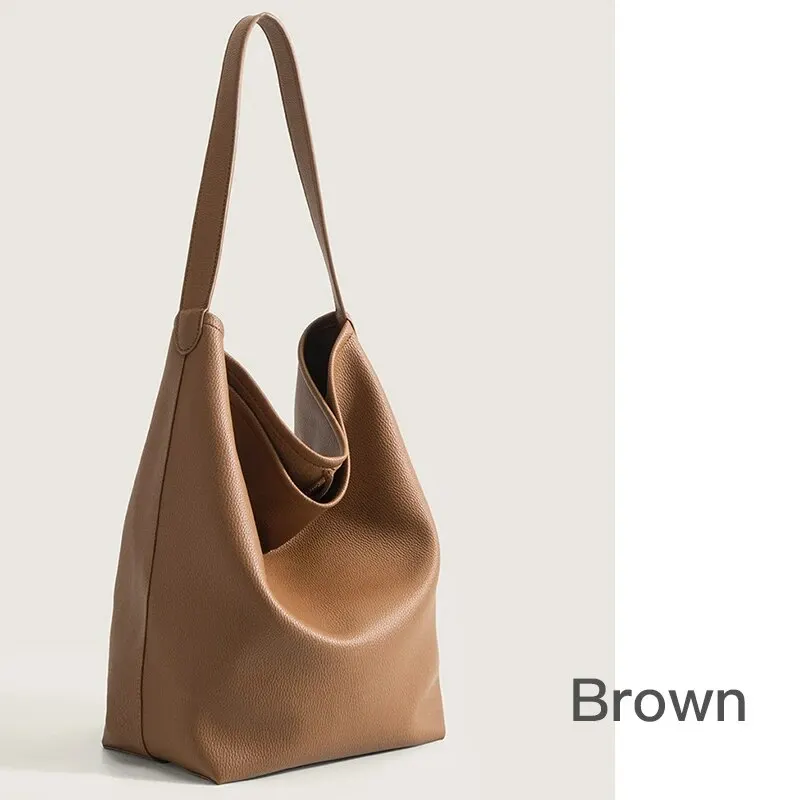
Advantages of Canvas Messenger Bags: Practical Versatility
- Lightweight Design
Canvas messenger bags typically weigh 30-50% less than their leather counterparts. This significant weight reduction translates to greater comfort during daily commutes, especially for those walking or using public transportation. The lighter base weight also allows for carrying more items without reaching uncomfortable total weights. For professionals who transport laptops, tablets, and documents daily, this reduced carrying burden can make a meaningful difference in comfort.
- Affordability
Canvas offers substantially lower entry prices for quality bags. While premium canvas options exist, good quality canvas messenger bags typically range from $50-$150, compared to $150-$500+ for comparable leather options. This accessibility allows more budget flexibility and makes replacing bags less financially impactful. The lower price point also permits owning multiple bags for different purposes without significant investment.
- Style Versatility
Canvas accepts dyes and prints more readily than leather, opening up vast design possibilities. From subtle earth tones to vibrant patterns and custom graphics, canvas bags offer greater creative expression. The material works equally well in rugged, military-inspired designs and sleek, minimalist urban aesthetics. Many professionals appreciate this versatility when matching bags to different outfits or settings.
- Simple Maintenance
Many canvas bags offer straightforward care requirements compared to leather. Untreated canvas options are often machine washable (on gentle cycles), while spot cleaning works well for treated versions. The material doesn’t require regular conditioning or special storage considerations. This low-maintenance nature appeals to busy professionals seeking practical accessories that don’t add care tasks to their routines.
- Weather Adaptability
Waxed canvas, in particular, offers excellent water resistance that can exceed untreated leather. The wax coating causes water to bead and roll off rather than penetrating the fabric. Even standard canvas can be treated with aftermarket waterproofing sprays for improved weather protection. These weather-resistant properties make canvas bags particularly suitable for variable climate conditions.
- Eco-Friendly Options
Canvas offers multiple environmentally conscious options, including organic cotton canvas, recycled materials, and production methods with lower chemical impacts. The manufacturing process typically requires fewer resources than leather production. For environmentally mindful consumers, these stylish messenger bags leather canvas options provide attractive alternatives with reduced ecological footprints.
The canvas vs leather messenger bags comparison reveals that canvas excels particularly in everyday practicality, offering lighter weight, easier maintenance, and greater affordability while still providing good durability when well-constructed.
Considerations for Canvas Messenger Bags: Factors to Keep in Mind
- Structural Limitations
Canvas naturally lacks the rigid structure that leather provides, potentially leading to sagging or collapsing when heavily loaded. Over time, even well-made canvas bags may begin to lose their original shape, particularly at the bottom and sides where weight concentrates. This structural softening can affect both appearance and functionality, potentially making items harder to locate and retrieve. Some manufacturers address this through internal framing or reinforcement, but these solutions add weight and cost.
- Less Formal Appearance
Canvas projects a more casual image that may not align with formal business environments. In conservative professional settings like law, finance, or corporate executive roles, canvas messenger bags might appear too informal regardless of their quality or design. This perception limitation can restrict when and where the bag is appropriate to use, potentially requiring multiple bag options for different professional contexts.
- Varying Durability
The durability of canvas varies dramatically based on construction quality and material weight (measured in ounces or GSM—grams per square meter). Lightweight canvas (under 12oz) may develop tears or show wear quickly, while heavyweight options (16oz+) offer significantly better longevity. Stitching quality and reinforcement at stress points become particularly important with canvas, as these often fail before the material itself. This variability makes careful assessment of construction quality essential when selecting canvas bags.
- Water Vulnerability
Untreated canvas absorbs water rather than repelling it, potentially damaging contents and the bag itself. Standard canvas can become heavy when wet and may develop mildew if not dried properly. While waxed canvas addresses many of these concerns, the wax treatment requires periodic reapplication (typically every 1-2 years) to maintain effectiveness. This maintenance step adds complexity compared to the inherent properties of treated leather.
- Showing Wear
Canvas tends to show dirt, stains, and wear patterns more visibly than darker leather options. The material can develop frayed edges, visible creases, and color fading—especially in high-friction areas like corners and strap attachments. Unlike leather’s attractive patina development, canvas aging typically appears more as deterioration than enhancement, potentially shortening its aesthetically pleasing lifespan.
- Cleaning Challenges
While canvas is generally easier to clean than leather, certain stains can prove particularly difficult to remove. Oil-based stains may create permanent marks even with thorough cleaning. Additionally, the cleaning process itself can affect water-resistant treatments or cause slight shrinkage or color fading over time. These cleaning limitations require consideration for professionals who frequently encounter varied environments.
When choosing best messenger bag material, these considerations should be weighed against the advantages based on your specific needs and usage patterns.
Durability Face-Off: Which Material Stands the Test of Time?
When comparing the long-term durability of quality leather versus canvas messenger bags, several distinct patterns emerge regarding how each material ages and withstands daily use.
Expected Lifespan Comparison
Quality full-grain leather bags typically offer substantially longer functional lifespans than canvas alternatives. With proper care, premium leather bags can remain serviceable for 10-15+ years of regular use. High-quality waxed canvas, by comparison, generally provides 5-8 years of service before significant degradation occurs. Standard canvas typically offers 3-5 years of professional-looking service before visible wear compromises appearance.
Different Types of Wear
The materials respond differently to various stressors. Leather excels at resisting abrasion and punctures but can be vulnerable to deep scratches and water damage if left untreated. Canvas generally withstands folding and flexing better than leather but shows color fading from sun exposure more quickly. The edges and corners reveal particularly telling differences—leather edges can be burnished and finished to resist fraying, while canvas edges often show wear first, even in well-constructed bags.
Impact of Care Routines
Both materials benefit from appropriate care, but leather’s durability is more directly tied to maintenance routines. Regular conditioning prevents the cracking and drying that can significantly shorten leather’s lifespan. Canvas requires less frequent maintenance but still benefits from appropriate cleaning and reproofing of water-resistant treatments. The Louis Vuitton canvas leather durability comparison demonstrates how premium canvas construction with quality leather trim creates a balance that preserves structural integrity while maintaining lighter weight.
Repair Possibilities
Leather offers superior repair potential compared to canvas. Skilled leather repair specialists can address many issues including torn stitching, worn handles, and even patch damaged sections while maintaining aesthetic appeal. Canvas repairs tend to be more visible and may compromise water resistance or structural integrity. This repairability factor extends leather’s functional lifespan significantly, while canvas bags often reach a point where replacement becomes more practical than repair.
Long-Term Value Assessment
When assessing long-term value, leather typically offers better return on investment despite higher initial costs. A $300 leather bag lasting 12 years costs approximately $25 per year of service. A $120 canvas bag lasting 4 years costs $30 per year. This calculation favors quality leather even more when considering potential repair and continued use beyond initial lifespan estimates.
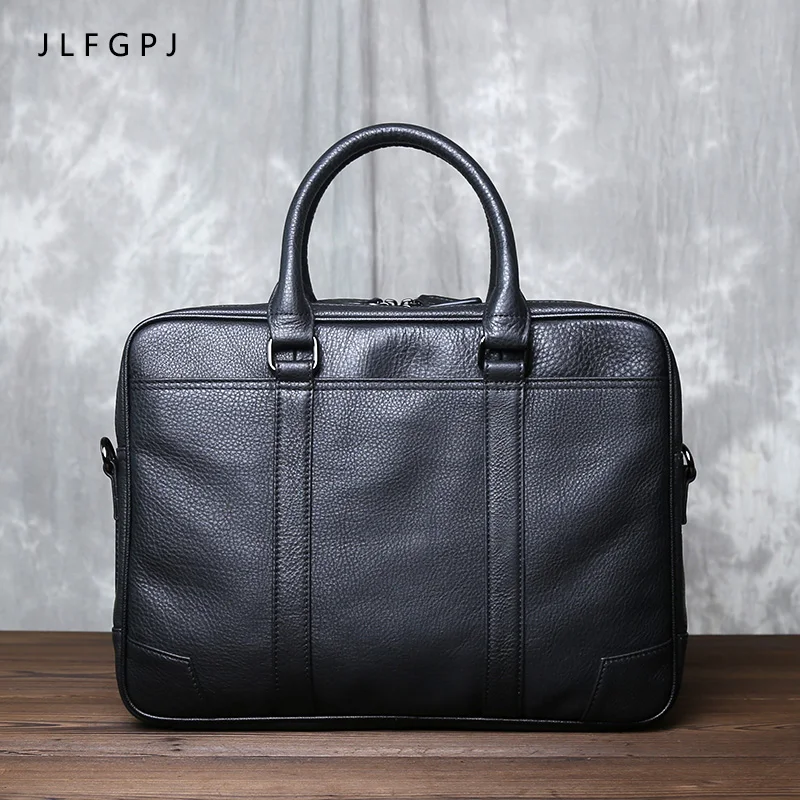
Practical Maintenance: Care Requirements Compared
Leather Maintenance Routine
Regular Care (Every 1-3 Months):
– Dust with soft, dry cloth
– Apply quality leather conditioner sparingly
– Allow to absorb fully (typically 12-24 hours)
– Buff with clean cloth to restore luster
– Estimated time: 15-20 minutes plus drying time
Cleaning Process (As Needed):
– Remove surface dirt with slightly damp cloth
– For stains: Apply specialized leather cleaner with soft cloth
– Work in small circular motions
– Wipe clean and allow to dry completely
– Follow with conditioner to restore moisture
– Estimated time: 20-30 minutes plus drying time
Special Treatments:
– Water/stain repellent every 3-6 months
– Edge dressing for exposed leather edges annually
– Storage with cedar blocks or silica gel packets
– Keep away from direct sunlight and heat sources
– Stuff with acid-free tissue when not in use
Canvas Maintenance Routine
Regular Care (Monthly):
– Brush off surface dirt with soft brush
– Spot clean stains immediately with mild soap and water
– Air dry completely before storage
– Estimated time: 5-10 minutes
Deep Cleaning (As Needed):
– Untreated canvas: Hand wash with mild detergent or machine wash on gentle cycle
– Waxed canvas: Wipe with damp cloth only
– Air dry completely (never machine dry)
– Estimated time: 15 minutes plus drying time
Special Treatments:
– Re-wax waxed canvas annually with appropriate wax product
– Apply waterproofing spray to untreated canvas every 3-6 months
– Store in cool, dry place
– Avoid prolonged sun exposure
Addressing Common Issues
Water Damage:
– Leather: Blot excess water immediately, allow to air dry naturally away from direct heat, apply conditioner once dry
– Canvas: Blot excess, stuff with paper towels to maintain shape while drying, brush once completely dry
Stains:
– Leather: Specialized leather cleaner, conditioner after cleaning
– Canvas: Mild soap solution, spot clean immediately, avoid saturating
Structural Issues:
– Leather: Professional repair recommended for stitching or structural damage
– Canvas: Basic sewing repairs possible for owners with sewing skills
The maintenance requirements for leather laptop satchel options tend to be more time-intensive but focus on preservation and enhancement. Canvas maintenance is generally simpler but often addresses cleaning rather than material improvement. Both materials benefit significantly from preventative care and prompt attention to issues when they arise.
Style and Aesthetics: Finding Your Personal Expression
The aesthetic qualities of leather and canvas messenger bags create distinctly different style statements that resonate with different professional identities and personal preferences.
Leather’s Classic Appeal
Leather messenger bags project sophistication and established professionalism. The material’s natural luster and rich texture communicate attention to detail and quality consciousness. Leather bags typically feature cleaner lines and more structured silhouettes that complement formal business attire. As leather ages, it develops a personalized patina—a warm glow and subtle color variations that tell the story of its use. This unique aging process means a quality leather bag looks distinctly better after years of use than when new, a rare quality in accessories.
Canvas’s Contemporary Character
Canvas messenger bags convey approachability and practical creativity. The material’s texture and casual appearance align naturally with today’s more relaxed professional environments. Canvas accepts colors and patterns more readily than leather, allowing for greater personalization and visual expression. While canvas doesn’t develop patina like leather, well-designed canvas bags can achieve a comfortable, lived-in look that many find appealing. The material’s inherent informality pairs particularly well with business casual and creative professional wardrobes.
Wardrobe Versatility
Leather bags traditionally complement formal business attire—suits, dress shoes, and structured clothing. Their refined appearance elevates even casual outfits but may sometimes appear overly formal with very casual attire. Canvas bags shine in casual and business casual environments, pairing effortlessly with jeans, chinos, and unstructured blazers. They communicate a more relaxed professional identity aligned with creative fields and contemporary workplaces.
Design Possibilities
Leather’s natural properties limit certain design elements—very bright colors or complex patterns typically require treatment that may compromise leather’s natural characteristics. However, leather excels in subtle details like embossing, burnishing, and developing rich depth of color over time. Canvas offers greater design flexibility, accepting vibrant colors, patterns, and graphics that would be impossible with natural leather. This versatility makes canvas particularly suitable for expressing personal style through accessories.
Seasonal Considerations
Leather messenger bags maintain their professional appearance year-round but can be perceived as heavier and more substantial in warmer months. Canvas bags have traditional associations with spring and summer due to their lighter weight and casual appearance, though modern designs transcend strict seasonal limitations. The vintage style messenger bag aesthetic works particularly well across seasons in either material, with leather developing more character over time.
Your aesthetic choice ultimately reflects both practical considerations and how you wish to be perceived professionally. Both materials offer distinct visual languages that communicate different aspects of professional identity.
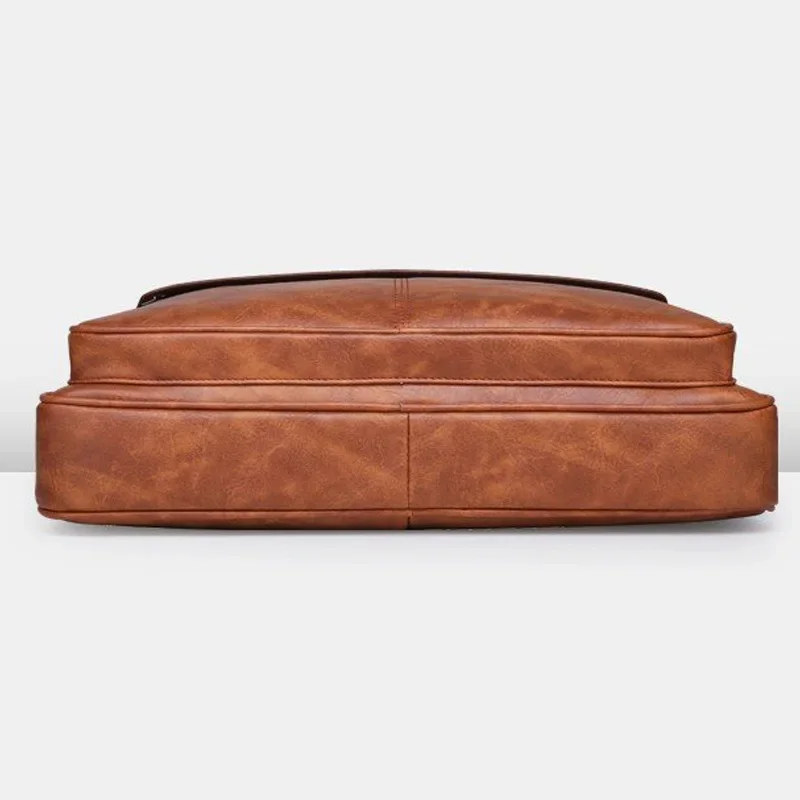
Weather Resistance and Protection: Keeping Contents Safe
Weather resistance represents a crucial factor in messenger bag material selection, particularly for commuters and travelers who regularly encounter varying conditions.
Natural Weather Protection Properties
Untreated leather offers moderate natural water resistance due to its dense fiber structure and natural oils. Light rain typically beads on the surface before penetration occurs. However, prolonged exposure can lead to water absorption, potential staining, and in extreme cases, warping or shape distortion. Quality leather that’s been properly treated significantly improves this natural resistance.
Untreated canvas provides minimal inherent water resistance—the natural fibers readily absorb moisture, potentially transferring it to contents. When wet, standard canvas becomes heavier and may develop mildew if not dried properly. Waxed canvas, however, offers excellent water resistance that can exceed untreated leather, with water beading and rolling off the waxy surface.
Enhancement Options
Leather can be treated with specialized waterproofing products that create an invisible barrier against moisture. Quality leather protectants like Saphir Super Invulner or Obenauf’s Heavy Duty LP provide significant water resistance without altering appearance. These treatments typically need reapplication every 3-6 months depending on weather exposure.
Canvas waterproofing options include spray-on treatments like Scotchgard or Nikwax Cotton Proof that create a hydrophobic barrier. Waxed canvas requires periodic re-waxing (typically annually) to maintain its water-resistant properties. This process involves applying appropriate wax and gently heating it to penetrate the fibers.
Recovery After Exposure
When leather gets wet, proper drying becomes critical. Blot (don’t rub) excess moisture, stuff the bag with newspaper or paper towels to maintain shape, and allow to air dry naturally away from direct heat sources. Once completely dry, apply conditioner to restore flexibility and prevent cracking.
Wet canvas should also be blotted and stuffed to maintain shape while drying. Unlike leather, canvas can develop mildew more readily if not dried thoroughly. Once dry, brushing with a soft brush helps restore the material’s appearance and texture.
For professional laptop messenger bags, additional interior protection becomes essential regardless of exterior material. Padded laptop compartments, water-resistant interior linings, and sealed seams provide crucial secondary protection for valuable electronics and documents.
Both materials can offer good weather protection when properly selected and maintained, but their requirements and limitations differ significantly. Leather requires more regular treatment but often provides better long-term protection, while waxed canvas offers excellent out-of-the-box weather resistance with periodic maintenance needs.
Perfect Match: Choosing Based on Your Lifestyle
The Professional Commuter
Professional commuters who navigate urban environments daily need a bag that balances professionalism with practical durability. For those in formal business settings (finance, law, corporate leadership), leather messenger bags offer the appropriate executive presence while providing necessary document protection. The natural structure of leather helps maintain organization during transit and presents well in client meetings or boardrooms.
For professionals with longer walking commutes or who regularly navigate public transportation, weight becomes a significant factor. In these cases, either a lightweight leather option or a structured canvas bag might prove ideal. Those commuting in unpredictable weather should consider waxed canvas or heavily treated leather for consistent content protection.
The Academic/Student
Students and educators typically prioritize affordability, weight, and versatility. Canvas messenger bags excel in the academic environment, offering sufficient durability at accessible price points. The more casual appearance aligns well with educational settings, while the lighter weight accommodates carrying textbooks and technology between classes.
For graduate students or professors who straddle academic and professional worlds, hybrid bags with canvas bodies and leather trim offer an elegant compromise—maintaining lighter weight while adding professional touch points. The organization features become particularly important for this group, with separate compartments for teaching materials and research documents.
The Frequent Traveler
Travelers face unique challenges including security screenings, variable weather, and the need for quick access to documents. Premium waxed canvas offers an excellent balance for travelers—lightweight yet durable, weather-resistant, and less likely to show scuffs from frequent handling. The flexibility of canvas also allows easier fitting into overhead compartments or under seats.
Business travelers who regularly attend client meetings may prefer slim leather messenger bags that transition seamlessly from airport to boardroom. These travelers should prioritize bags with trolley straps that attach to rolling luggage handles, reducing carrying strain during transit.
The Urban Explorer
Those who use their messenger bag for both work and weekend adventures need maximum versatility. Canvas typically offers better crossover appeal from professional to casual settings, with weather-treated options standing up to outdoor elements. Urban explorers benefit from bags with convertible carrying options—shoulder straps that adjust for cross-body carrying when cycling or navigating crowded spaces.
The Technology Professional
Tech professionals carrying multiple devices need superior organization and protection. Structured leather messenger bags with padded compartments provide excellent protection for valuable electronics while projecting professional competence. For those in more casual tech environments, canvas options with reinforced bottoms and water-resistant treatments offer practical protection with a more relaxed aesthetic.
The everyday use messenger bags that best serve each lifestyle differ significantly based on these specific needs. When selecting your ideal material, prioritize the factors most relevant to your daily patterns and professional requirements rather than general recommendations.
Cost Analysis: Initial Investment vs. Lifetime Value
Understanding the true cost of messenger bags requires looking beyond the initial price tag to consider the total ownership experience and cost-per-use over time.
Initial Price Comparison
Leather Messenger Bags:
– Entry-level genuine leather: $150-$250
– Mid-range top-grain leather: $250-$400
– Premium full-grain leather: $400-$800+
Canvas Messenger Bags:
– Basic canvas: $50-$100
– Premium canvas/waxed canvas: $100-$250
– Designer canvas: $250-$450
This initial price difference creates a significant upfront cost disparity, with quality leather options typically requiring 2-4 times the investment of comparable canvas alternatives.
Lifetime Cost Calculation
To understand true value, we must consider expected lifespan and calculate cost-per-use:
Full-grain leather bag ($450):
– Expected lifespan: 12 years with proper care
– Usage: 5 days per week, 50 weeks per year = 250 uses annually
– Total uses: 3,000 over lifetime
– Cost per use: $0.15
Quality canvas bag ($150):
– Expected lifespan: 4 years with regular use
– Usage: 5 days per week, 50 weeks per year = 250 uses annually
– Total uses: 1,000 over lifetime
– Cost per use: $0.15
This simplified calculation suggests that despite higher initial investment, quality leather can provide comparable or better value over its full lifespan. The calculation becomes even more favorable for leather when considering potential repairs that extend useful life.
Maintenance Costs
Both materials incur ongoing maintenance costs that should factor into total ownership calculations:
Leather:
– Quality conditioner: $15-$25 annually
– Waterproofing treatment: $15-$20 annually
– Potential professional cleaning: $30-$50 every few years
– Potential repair costs: $50-$150 if needed
Canvas:
– Waterproofing spray: $10-$15 annually
– Re-waxing supplies (for waxed canvas): $15-$25 annually
– Cleaning supplies: Minimal
While leather maintenance products cost more, the difference is relatively small compared to the initial purchase price difference.
Resale Value
Quality leather bags typically retain significant resale value when well-maintained—often 30-50% of original price even after years of use. Canvas bags generally have minimal resale value regardless of original quality. This resale potential further enhances leather’s lifetime value proposition for those who occasionally update their accessories.
For those interested in leather document bag options as an investment, considering these long-term value factors often justifies the premium initial price. However, canvas provides excellent short-term value for those with budget constraints or who prefer to update their accessories more frequently.
Black Leather Briefcase, Leather Document Bag, Men's Classic Leather Briefcase
Genuine Crocodile Leather Executive Briefcase with Password Lock – Premium Business Document Carrier$1,201.87 Select options This product has multiple variants. The options may be chosen on the product pageCanvas & Leather Messenger Bag, Leather Commuter Tote
$80.41 Select options This product has multiple variants. The options may be chosen on the product pageCrazy Horse Leather Satchel, Men's Leather Satchel, Men's Professional Leather Messenger, Vintage Style Messenger Bag
$132.70 Select options This product has multiple variants. The options may be chosen on the product pageBrown Leather Messenger Bag, Men's Leather Satchel, Men's Professional Leather Messenger
$118.87 Select options This product has multiple variants. The options may be chosen on the product pageBlack Leather Messenger Bag, Black Leather Work Tote, Faux Leather Work Tote
$101.88 Select options This product has multiple variants. The options may be chosen on the product pageCrazy Horse Leather Satchel, Leather Laptop Satchel, Men's Leather Satchel
$304.47 Select options This product has multiple variants. The options may be chosen on the product page
Environmental and Ethical Considerations
The environmental impact of messenger bags varies significantly depending on material source, production methods, and expected lifespan—all factors worth considering for environmentally conscious consumers.
Leather Production Impact
Traditional leather production raises several environmental concerns. The tanning process often uses chromium and other chemicals that can contaminate water systems if not properly managed. Additionally, livestock raising contributes to greenhouse gas emissions and land use impacts. However, these impacts vary dramatically based on sourcing and processing methods.
More sustainable leather options include vegetable-tanned leather, which uses plant-based tannins rather than chromium, and leather sourced as a byproduct from food production rather than from dedicated leather-production operations. These alternatives significantly reduce the environmental footprint while maintaining leather’s durability advantages.
Canvas Environmental Considerations
Canvas generally starts with a lower environmental impact than leather, particularly when made from organic cotton or recycled materials. The production process requires fewer chemicals and creates less pollution than conventional leather tanning. However, conventional cotton cultivation uses significant water resources and often involves pesticides that impact soil and water quality.
Recycled canvas and organic cotton options represent the most environmentally friendly canvas choices, reducing both resource consumption and chemical use. Hemp canvas offers another sustainable alternative with lower water requirements and natural pest resistance that reduces chemical applications.
Durability as Sustainability
Perhaps the most significant environmental factor is product lifespan. A bag that lasts three times longer represents significantly reduced resource consumption compared to replacing lower-quality options repeatedly. From this perspective, well-made leather bags often represent the more sustainable choice despite higher initial environmental impact, as their extended lifespan amortizes that impact over more years of use.
Ethical Material Sourcing
Beyond environmental considerations, ethical sourcing has become increasingly important to many consumers. For leather, this includes animal welfare considerations and working conditions in tanneries. For canvas, labor practices in textile production and cotton farming raise similar ethical questions.
Certifications like Leather Working Group for leather products and Global Organic Textile Standard for canvas provide some assurance of more responsible production practices. Additionally, companies with transparent supply chains and published ethical standards typically maintain higher production standards.
The guide vegan leather alternatives explores ethical options beyond traditional materials, including innovative plant-based leathers made from pineapple leaves, apple peels, and mushrooms, as well as advanced synthetic options with improved environmental profiles compared to older vinyl-based alternatives.
For environmentally conscious consumers, the ideal choice depends on personal priorities—immediate environmental impact versus long-term sustainability through durability. Regardless of material choice, selecting from manufacturers with transparent production practices and demonstrated environmental commitments offers the best assurance of responsible consumption.
Making Your Decision: A Practical Framework
Choosing between leather and canvas messenger bags becomes simpler with a structured approach that aligns with your specific needs and priorities.
Priority Assessment Exercise
Begin by ranking these factors in order of importance to your specific situation:
1. Professional appearance/formality
2. Weight/comfort during carrying
3. Long-term durability
4. Initial budget constraints
5. Weather protection requirements
6. Maintenance willingness
7. Environmental considerations
Your rankings will naturally guide you toward one material over the other, as each excels in different areas.
Choose Leather If…
- You work in formal business environments where professional appearance directly impacts credibility
- You view your bag as a long-term investment and prefer items that improve aesthetically with age
- You prioritize structural integrity for protecting electronics and maintaining organization
- You value the distinctive character development of natural materials
- You’re willing to perform regular but simple maintenance to preserve quality
- Your typical use involves minimal extended carrying or commuting by foot
Leather particularly suits those who value timeless aesthetics, appreciate craftsmanship, and seek accessories that develop unique character with use. The investment perspective—buying better quality less frequently—aligns with leather’s value proposition.
Choose Canvas If…
- You prioritize lightweight comfort for daily commuting or frequent travel
- You work in casual or creative professional environments where formal appearance is less critical
- Your budget constraints make initial affordability an important consideration
- You prefer minimal maintenance requirements and easy cleaning
- You frequently encounter unpredictable weather conditions (especially with waxed canvas)
- You value design versatility including color options and pattern choices
- Environmental impact of production processes is a primary concern
Canvas serves those who prioritize practical functionality, appreciate contemporary casual aesthetics, and prefer accessories that solve immediate needs without significant maintenance requirements.
Quality Indicators for Both Materials
Regardless of which material you choose, certain quality markers transcend material type:
For Leather Bags:
– Full-grain or top-grain leather specification
– Visible edge finishing techniques
– Reinforced stitching at stress points
– Quality hardware (brass or stainless steel)
– Smooth, consistent zipper operation
For Canvas Bags:
– Heavy weight canvas (12oz minimum, 16oz+ preferred)
– Reinforced bottom panel
– Double-stitched seams
– Water-resistant interior lining
– Quality hardware and attachments
Remember that significant quality variation exists within both material categories. A premium canvas bag will outperform and outlast a poor-quality leather bag. Focusing on construction quality often matters more than the base material choice.
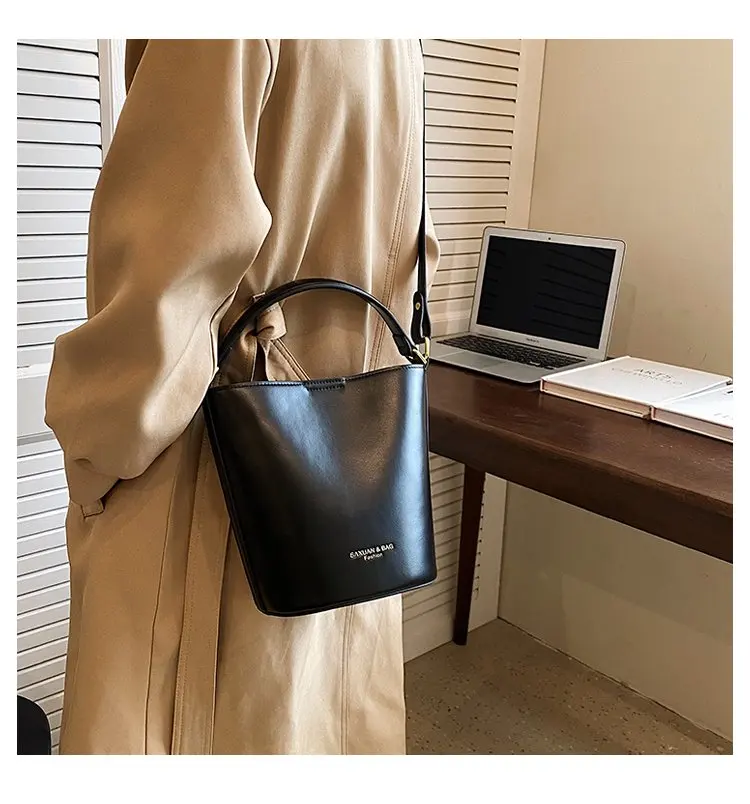
Frequently Asked Questions (FAQ) About Messenger Bag Materials
Is leather or canvas more durable?
Quality full-grain leather typically offers superior long-term durability compared to canvas. With proper care, premium leather messenger bags can last 10-15+ years of regular use, while even high-quality canvas bags generally provide 5-8 years of service. Leather’s natural fiber structure resists tears and punctures while maintaining structural integrity over time. However, durability varies significantly based on quality within each material category—a premium waxed canvas bag will outlast a poorly constructed genuine leather bag.
How do I waterproof my canvas messenger bag?
For untreated canvas bags, apply a specialized fabric waterproofing spray like Scotchgard or Nikwax Cotton Proof. Clean the bag thoroughly first, then spray evenly in a well-ventilated area, holding the bottle 6-8 inches from the surface. Apply two light coats rather than one heavy application, allowing 30-60 minutes drying time between coats. Reapply every 3-6 months depending on usage and weather exposure. For waxed canvas, periodically refresh the wax coating using a compatible wax product applied with a soft cloth and gently heated with a hairdryer to help it penetrate the fibers.
Can leather messenger bags be used in rain?
Yes, but with appropriate preparation and care. Quality leather bags with proper treatment can handle light to moderate rain exposure. Apply a leather waterproofing product every 3-4 months for regular protection. During rainy conditions, periodically blot (don’t rub) water from the surface when possible. After exposure to significant moisture, stuff the bag with paper towels or newspaper to maintain shape while drying naturally away from direct heat sources. Once completely dry, apply leather conditioner to prevent stiffening or cracking. Consistent treatment and proper drying techniques allow leather bags to withstand occasional rain without damage.
Which material is better for carrying laptops?
Both materials can safely transport laptops when properly constructed. Leather provides better natural structure and often superior padding due to its firmer character, creating a protective shell around devices. Canvas bags require more intentional internal padding and reinforcement to offer comparable protection. For maximum laptop safety, look for bags with dedicated padded laptop compartments regardless of exterior material. The bag’s construction—including padding thickness, compartment design, and bottom reinforcement—matters more than the exterior material when evaluating laptop protection.
How do I remove stains from leather/canvas bags?
For leather stains, blot (don’t rub) the stain immediately. For oil-based stains, sprinkle talcum powder or cornstarch to absorb excess oil, then gently brush away after several hours. For water-based stains, use a slightly damp cloth with mild leather cleaner, working in small circular motions. Always test cleaners on an inconspicuous area first and follow with leather conditioner after cleaning.
For canvas stains, address them immediately by blotting (not rubbing). Create a solution of mild soap and water, gently cleaning in circular motions with a soft cloth. For stubborn stains on untreated canvas, make a paste with baking soda and water, apply to the stain, let dry completely, then brush off. Waxed canvas should only be spot cleaned with damp cloth—no soaps or detergents that might damage the wax coating.
Can canvas messenger bags look professional?
Yes, canvas messenger bags can appear professional, particularly in contemporary work environments. Premium waxed canvas in neutral colors with quality leather trim creates a refined appearance suitable for many professional settings. Construction quality significantly impacts professional appearance—well-structured canvas bags with clean lines and minimal external hardware present a more professional image than unstructured designs. While traditional canvas may not be appropriate for highly formal business environments, modern premium canvas designs work well in creative professions, education, technology, and business casual settings.
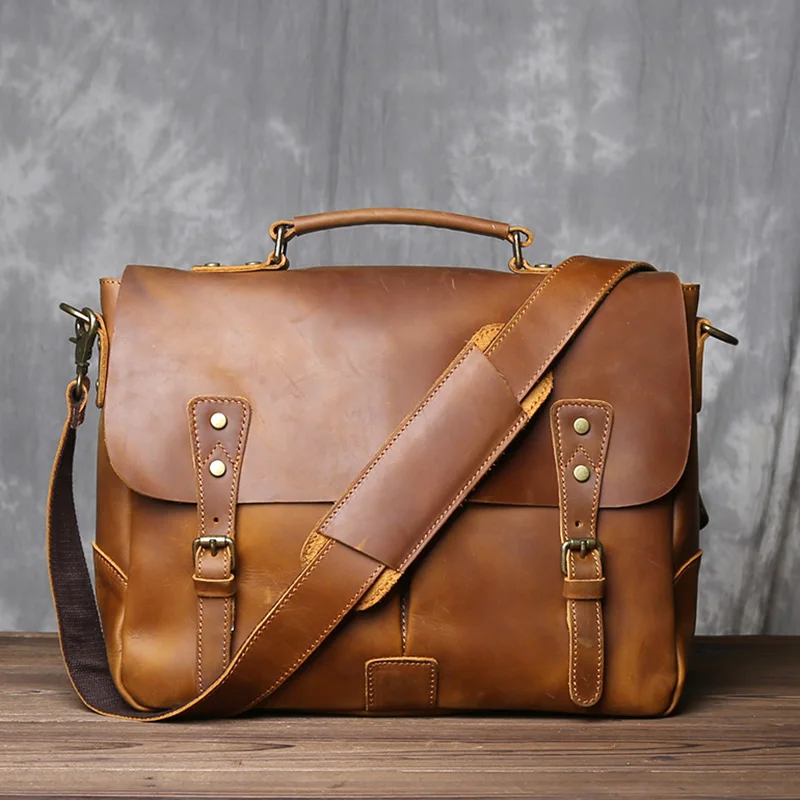
Hybrid Options: The Best of Both Worlds
Hybrid messenger bags combining leather and canvas elements have emerged as a compelling solution for those seeking the advantages of both materials. These designs strategically incorporate each material where its properties provide maximum benefit.
Strategic Material Placement
The most common hybrid configuration features a canvas body with leather trim and reinforcement at critical wear points. This design places leather at corners, bases, straps, and closure flaps—areas that experience the most stress and abrasion. The canvas forms the main body, providing lightweight flexibility and reducing overall weight. This strategic material allocation enhances durability while maintaining a lighter carry than full-leather construction.
More premium hybrid designs use leather for the entire front flap and bottom panel, with canvas for the body and back panel. This configuration creates a professional face that presents well in meetings while reducing weight and adding weather resistance where most needed.
Practical Advantages
Hybrid designs address several key limitations of single-material bags. The leather reinforcements significantly extend the lifespan of canvas components by protecting high-wear areas. Meanwhile, the canvas body reduces the overall weight compared to full-leather options, typically resulting in bags 25-40% lighter than comparable all-leather designs.
From a maintenance perspective, hybrids require a balanced approach—leather components need conditioning, while canvas sections need appropriate cleaning. This divided maintenance can actually prove easier, as each material can receive its optimal care without compromising the other.
Aesthetic Considerations
Visually, hybrid bags occupy a unique middle ground between formal and casual. The leather elements add sophistication and professional polish, while canvas components provide a more relaxed, contemporary feel. This balanced aesthetic works particularly well in modern professional environments that blend formal and casual elements.
The contrast between materials creates visual interest through texture and color variations that single-material bags cannot achieve. Popular combinations include tan or brown leather with olive, navy, or khaki canvas—color pairings that reference heritage workwear while maintaining professional appropriateness.
For those struggling to choose between leather and canvas, quality hybrid designs offer a genuine “best of both worlds” solution rather than a compromise. By placing each material where its properties are most beneficial, these bags achieve a balance of durability, weight, weather resistance, and aesthetic appeal that serves modern professionals particularly well.
Finding the perfect messenger bag ultimately comes down to understanding your specific needs and how each material’s properties align with your professional life, personal style, and practical requirements. Whether you choose leather, canvas, or a hybrid design, prioritizing quality construction will ensure your investment serves you well for years to come.

